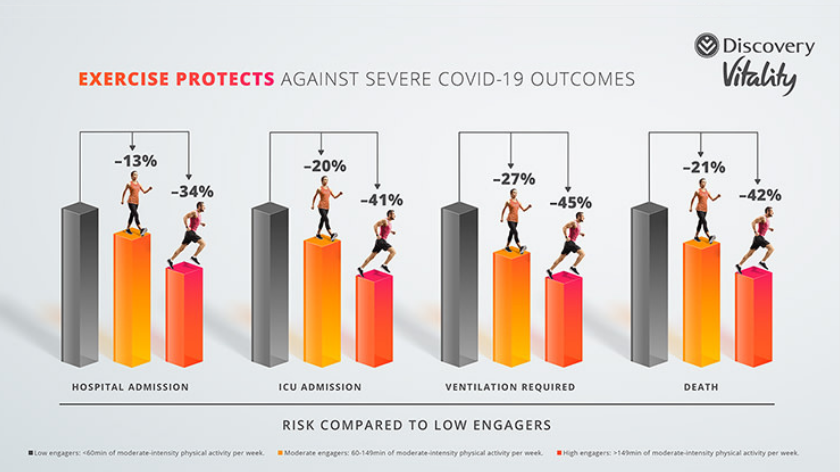Have you ever skipped out on a workout entirely because you only had a short window of time available? Or decided that a walk around your neighborhood wasn’t worth it because it wasn’t going to get your heartrate pumping the same way a cardio session at the gym would? Many of us wrongly assume that unless we can carve out time for an intense workout session that leaves us dripping in sweat and gasping for air, that time is not well spent.
New research from Discovery Vitality highlights just how wrong we are. The study, published in the British Journal of Sports Medicine, is the first study globally using objectively recorded physical activity data to show the protective effects of physical activity on COVID-19 outcomes. The study analyzed two years of physical activity data from smart devices, clocked gym attendance, and participation in sporting events from 65,000 Vitality members infected with COVID-19. Participants were categorized into three categories: high engagers (150+ minutes of moderate-intensity physical activity per week), moderate engagers (60-149 minutes of moderate-intensity physical activity per week), and low engagers (less than 60 minutes of moderate-intensity physical activity per week). Of note, the World Health Organization recommends adults complete at least 150 minutes of moderate-intensity physical activity per week, putting their recommendation in line with the “high engager” group.
The study found that high engagers, or those meeting WHO recommendations, had a 34% lower risk of hospital admission, a 41% lower risk of ICU admission, a 45% lower risk of requiring ventilation, and a 42% lower risk of death, as compared to those with the lowest levels of physical activity. Even the moderate engagers, who were below the WHO recommendations, saw substantial benefit from their activity levels, with a 13% lower risk of hospital admission, 20% lower risk of ICU admission, 27% lower risk of ventilation, and 21% lower risk of death. Further, physical activity at high levels was shown to have a particularly beneficial effect on those at higher risk for severe COVID-19 outcomes, including those who are elderly, male, or have hypertension or diabetes.
This study highlights the importance of physical activity in improving COVID-19 outcomes, even at levels below the WHO recommendations. So, the next time you’re thinking about skipping your workout because you may not have the time or energy to fit in a long, intense workout…think again!
Lianne E. Jacobs, MPH, Health Communications Strategist, has a master’s degree in public health from Yale University. She is the only indoor cycling instructor who can’t ride a bike. She enjoys traveling the world, laughing at her own jokes, and tricking her husband into eating baked goods made with hidden vegetables.







